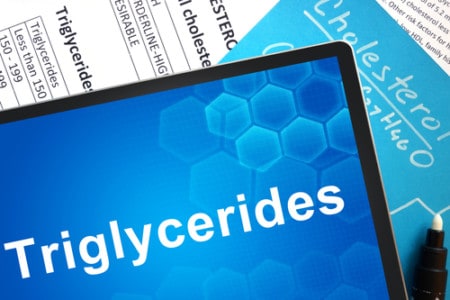High triglyceride levels – measured on all standard cholesterol tests – are way too common these days. Interestingly, high triglycerides are often ignored by most doctors. In some cases, they will “treat” high triglycerides with prescription drugs, such as fibrates (Lopid, fenofibrate) or prescription fish oil (Lovaza). Unfortunately, neither of these approaches addresses WHY triglycerides are high in the first place. As with all lab values out of range, it’s important to look deeper into the cause and correct the imbalance rather than simply medicate the symptom. Fortunately, triglycerides are fairly simple to re-balance with targeted nutrition, supplements and lifestyle changes.
Triglyceride levels above 60 mg/dl can:
- Block insulin, thereby adding to weight gain and higher blood sugars
- Cause formation of small LDL particles. Triglycerides occur in the bloodstream mostly as Very Low-Density Lipoproteins, VLDL, that interact with other lipoprotein particles. Abundant triglycerides in VLDL encounter LDL particles and make them triglyceride-rich. This leads to the formation of small LDL particles that causes coronary heart disease and heart attack.
- At levels above normal, the pancreatic beta cells that produce insulin can be damaged, leading to inadequate insulin production by the pancreas over time.
- At very high levels above 1000 mg/dl, triglycerides cause pancreatitis, pancreatic inflammation that damages pancreatic tissues.
The higher the triglycerides, the higher the cardiovascular risk either through formation of small LDL particles or by other means.
What causes triglycerides to rise?
For most people, excessive carbohydrate intake is the primary reason for high triglycerides. Carbohydrates in the diet are converted to triglycerides in the liver. This accounts for a much greater rise in triglycerides than dietary fat. When triglycerides manufactured by the liver stay there and accumulate, they can cause fatty liver.
What you can do:
- Eliminate grains and sugars–Contrary to the conventional advice to reduce fat and eat plenty of “healthy whole grains,” the amylopectin A carbohydrate unique to grains stimulates triglyceride formation. High blood sugars that result from grain amylopectin A also lead to insulin resistance. The result: high triglycerides. Limiting carbohydrate intake to 15 grams net carbohydrates per meal (net carbs = total carbs – fiber) or less is recommended. Do not reduce healthy dietary fat, as this raises triglycerides substantially.
- Reverse insulin resistance– In addition to eliminating sugars and grains, you can improve insulin sensitivity by optimizing vitamin D levels, getting adequate sleep, and physical activity. Intermittent fasting, fasting for periods of 15-36 hours (while hydrating very well) has also been shown to help improve insulin resistance.
- Include high quality omega-3 fatty acids from fish oil–The EPA and DHA of fish oil activate the enzyme lipoprotein lipase that helps accelerate clearance of both cholesterol particles. Dosing is around 3000mg EPA + DHA per day (divided into two doses). Quality matters but prescription fish oil is not necessarily great quality. Companies like Nordic Naturals and Metagenics provide excellent quality.
- Improve your gut flora–Feed your gut bacteria the fibers they need allow them to convert fiber into butyrate, a fatty acid that yields metabolic effects that include reduction of insulin resistance, reduced blood sugar, reduced LDL values, and reduced triglycerides.
There’s so much you can control to get your triglyceride levels healthy! Take charge of your health and avoid the side effects of medications and long term consequences of issues that are left unmanaged. Contact me if you would like more information or help on your journey!


